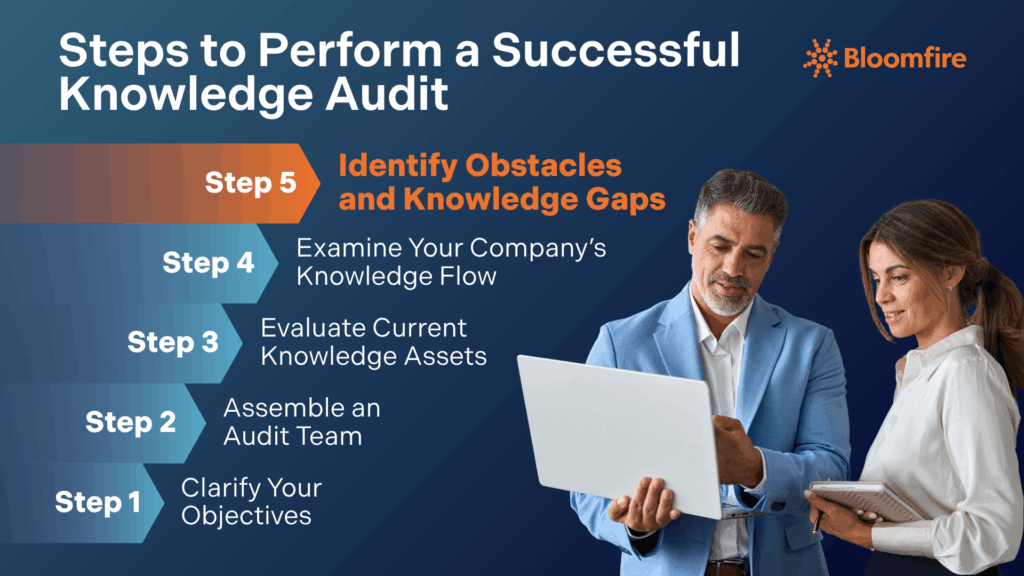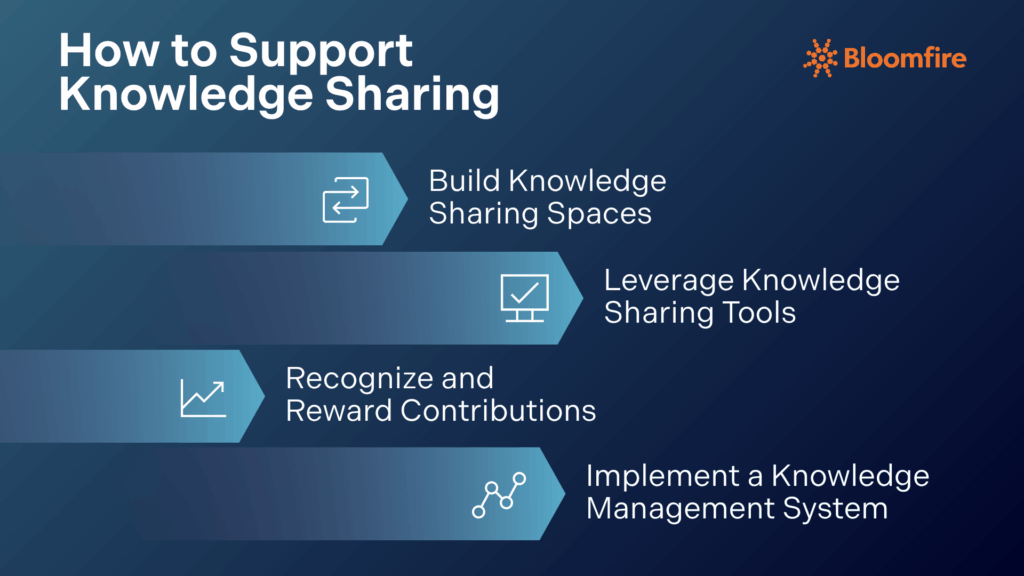How to Find and Assess Knowledge Gaps in Your Organization

Every action an employee takes is guided by the professional knowledge they’ve gathered throughout their education and career. However, business leaders often don’t realize that employees may lack critical information until they’ve made a costly mistake caused by knowledge gaps. And if your company doesn’t have a reliable process for identifying these gaps, they can slow productivity, hinder cross-team communication, and negatively impact the employee experience.
Knowledge gaps are discrepancies between what employees know and what your company needs them to know. You can identify and fill knowledge gaps by conducting knowledge audits, analyzing data, and facilitating knowledge-sharing sessions. Identifying gaps in knowledge will strengthen organizational performance by boosting efficiency, employee engagement, decision-making quality, and overall innovation, while reducing errors.
Perform a Knowledge Audit to find Knowledge Gaps
According to Bloomfire’s value report, only 25% of organizations have a structured method for identifying knowledge gaps. A great place to start when identifying knowledge gaps is to perform a knowledge audit. This is a thorough investigation of the information within your company, how it’s stored, and how it’s maintained.
Unlike a content audit, which analyzes all content your company has created, a knowledge audit examines how employees leverage knowledge content in their workflow. This helps identify any knowledge gaps across the company. It also helps leaders better understand whether you have any areas of opportunity in your knowledge gathering, sharing, and management processes.
Performing a knowledge audit reveals how knowledge flows, enhancing knowledge sharing and improving decision-making efficiency. Here are the five steps in completing a successful knowledge audit:

1. Clarify The Objectives of a Knowledge Audit
When beginning a knowledge audit, ask yourself: Why are you doing a knowledge audit, and what do you hope to achieve? For instance, you can build a knowledge management strategy, identify wants and needs for your knowledge management platform, or determine where to focus your knowledge documentation efforts. Understanding the goal of your knowledge audit ensures the process stays aligned with organizational goals, focuses data collection on relevant areas, and delivers actionable insights.
2. Assemble a Knowledge Audit Team
Loop in a few stakeholders from various departments or teams to help you better understand all the knowledge within your organization. Having a variety of perspectives will shed light on how other teams compile and use knowledge. Effectively managing your knowledge audit team will improve the accuracy, relevance, and impact of your audit process in driving strategic knowledge management initiatives.
3. Evaluate Current Knowledge Assets
Catalog the knowledge within your organization and where it lives. This information may be available on your company’s intranet, shared drives, or internal departmental documentation platforms. Categorize all of these knowledge assets by type, value, and accessibility, then assess their relevance, accuracy, and usefulness to organizational goals.
4. Examine Your Company’s Knowledge Flow
Examine how company knowledge is transferred between systems and individuals by conducting interviews with employees to understand their knowledge-sharing practices and challenges. You should also identify key knowledge sources, transfer channels, and bottlenecks or knowledge barriers. Utilize tools such as process mapping, flowcharts, or network analysis to visualize these knowledge exchanges and identify areas where knowledge is lost, duplicated, or delayed.
5. Identify Obstacles and Knowledge Gaps
By completing the first four steps, you will be able to easily pinpoint potential knowledge gaps, such as duplication issues, inexperienced employees in target areas, or whether knowledge assets are spread across disparate systems. This insight allows leadership to prioritize targeted interventions that strengthen knowledge sharing and organizational resilience. You’ll also want to identify whether there are any systems or processes that some groups are unaware of, or if anyone is hoarding knowledge that’s unavailable to other employees.
After completing a successful knowledge audit, organizations will typically implement knowledge management strategies guided by the audit’s findings. This ensures that knowledge assets are better leveraged across teams and platforms, resulting in enhanced performance and business outcomes. In return, employees gain faster access to knowledge, decision-making improves with more comprehensive insights, and overall productivity rises.
Support and Facilitate Knowledge Sharing Across the Organization

In addition to completing a knowledge audit, companies should also allow employees to request and share relevant knowledge. By utilizing knowledge sharing in your organization, you create a collaborative environment that accelerates decision-making and drives innovation. This boosts productivity and employee engagement, ultimately enhancing your organization’s agility and competitive advantage. There are methods to foster knowledge sharing in your organization, which include:
- Building Knowledge Sharing Spaces: Providing employees with space to share knowledge will help promote real-time asynchronous collaboration. Create physical and virtual environments to facilitate seamless knowledge sharing and discussion with other employees. Encouraging knowledge sharing sessions will accelerate onboarding and improve employee performance.
- Recognizing and Rewarding Contributions: Showing appreciation for employees who share knowledge helps reinforce a positive knowledge-sharing culture. Recognition programs, reward incentives, and leadership engagement encourage ongoing knowledge sharing participation. In turn, knowledge sharing will be valued as an organizational asset to fill knowledge gaps.
- Leveraging Knowledge Sharing Tools: Utilizing communication platforms like Slack and document collaboration tools like Google Docs enables active, real-time knowledge sharing no matter where employees are. Teams should also foster stronger interpersonal connections and encourage diverse communication styles that accommodate different learning preferences and needs for more effective knowledge sharing.
- Implementing a Knowledge Management System: A knowledge management system helps store all knowledge in one platform, ensuring easy retrieval of relevant information. This makes knowledge sharing simple, as there are no barriers to accessing the knowledge employees are seeking or want to share.
When employees freely and easily exchange expertise and insights, knowledge gaps naturally begin to close. According to Deloitte, 75% of organizations actually see knowledge sharing as a crucial part of company success. With knowledge sharing, teams gain access to diverse perspectives and previously untapped information, enabling them to address challenges more efficiently. Through consistent knowledge sharing, companies cultivate a culture where learning is continuous and information flows seamlessly across all levels, preventing any knowledge gaps.
Use Data to Identify Knowledge Gaps
Beyond finding unanswered questions, a knowledge management platform can help companies analyze user behavior and identify trends in knowledge usage. For example, you can discover which types of content receive the most engagement and examine the most frequently searched terms. If there’s something people are searching for that doesn’t yet exist, you’ll know to prioritize creating that asset.
To make this easier, Bloomfire shows which common search terms aren’t generating results, thereby highlighting existing knowledge gaps, so you know where to focus your energy.
Once you’ve identified your knowledge gaps, the next phase will be to develop new resources or update existing ones to close them. By staying on top of discrepancies between the information employees have now and what you need them to know, you can avoid inefficiencies and prevent knowledge silos from forming.
By making sure all employees have the knowledge they need when they need it most, you can improve the employee experience and help your organization meet its objectives. In return, many knowledge gaps will be closed and prevented in the future.
Develop and Execute a Plan to Close Knowledge Gaps
Once knowledge gaps are identified, the next step is to develop and execute plans to close these gaps. These KM initiatives can take various forms, like workshops, e-learning modules, mentoring programs, or personalized learning paths that align with employees’ roles and career goals. For instance, teams can create targeted learning initiatives tailored to the specific needs of different teams or individual employees.
Creating a culture that encourages continuous learning and open communication helps maintain motivation and engagement throughout this process. Leveraging technology, including learning management systems (LMS) and AI-powered knowledge sharing tools, enhances access to all company knowledge, which fosters ongoing education and allows for tracking progress.
A strong execution plan should include clear metrics and accountability measures to evaluate the effectiveness of knowledge learning efforts to ensure knowledge gaps are closing. Managers and team leaders should consistently review outcomes, gather feedback, and adjust KM strategies based on performance data and evolving organizational needs. By continuously refining their KM gap approach, organizations ensure that knowledge development remains dynamic, impactful, and closely aligned with business objectives.
How Closing Knowledge Gaps Leads to Enterprise Intelligence
Closing and preventing knowledge gaps is fundamental to building Enterprise Intelligence because it transforms fragmented information into a cohesive, self-healing knowledge base. Enterprise Intelligence combines knowledge management, business intelligence, and enterprise search into a dynamic, knowledge ecosystem.
Achieving Enterprise Intelligence can reduce search time by 46%, but only when knowledge is accurate and complete. When knowledge gaps are filled and information is correct, Enterprise Intelligence emerges as a dynamic capability that leverages integrated knowledge as a strategic asset. This boosts productivity, innovation, and long-term growth in an increasingly complex business environment.
Identifying gaps in knowledge not only strengthens your company’s knowledge foundation but also empowers data-driven decision-making at every level. As organizations continuously refine and expand their knowledge networks through Enterprise Intelligence, they unlock predictive insights that drive agility and foresight.
This seamless integration of connected knowledge transforms operational awareness into strategic advantage. As a result, teams anticipate challenges, respond faster to market shifts, and sustain a cycle of continuous learning that strengthens your organization’s competitive edge.
Frequently Asked Questions
What barriers prevent employees from sharing knowledge, and how can leadership model desired behaviors?
Some barriers that prevent employees from knowledge sharing include a lack of trust, siloed organizational structures, time constraints, inadequate technology, and resistance to change. Leadership can model desired behaviors by actively sharing knowledge themselves, and embedding practices into performance evaluations. When leaders communicate openly and participate in knowledge sharing, they set the organizational standard and reduce these barriers, paving the way for a more collaborative and innovative environment.
How can teams measure the impact of closing knowledge gaps on operational efficiency and employee retention?
Teams can measure the impact of closing knowledge gaps on operational efficiency and employee retention by tracking key performance indicators (KPIs) such as productivity improvements, reduction in repeated errors, and time-to-competency metrics. Additional measures include analyzing employee engagement, turnover rates, and the successful application of new knowledge in daily tasks. Using modern analytics dashboards, organizations can tie knowledge initiatives directly to operational success and retention improvements, making progress towards business goals visible and actionable.
How can unanswered questions in a Q&A tool reveal knowledge gaps?
A Q&A tool highlights areas where documented or accessible organizational knowledge is missing or insufficient. Persistent unanswered or frequently repeated questions signal persistent knowledge gaps, training needs, or areas requiring subject matter expertise. By analyzing Q&A tool data, organizations can adjust onboarding materials and training programs, ensuring critical knowledge gaps are addressed directly.
What role do employees play in highlighting knowledge gaps?
Employees play a critical role in highlighting knowledge gaps by sharing feedback, asking questions, participating in surveys, and flagging challenges encountered during their work. Through their daily tasks and direct communications, employees bring attention to unclear procedures, missing resources, or under-documented expertise, making it easier for leadership to prioritize targeted interventions. Their proactive contributions ensure that the most relevant and pressing knowledge gaps are identified and closed, improving organizational performance and collaboration.
How can a knowledge management platform support knowledge sharing and gap identification?
Knowledge management platforms support knowledge sharing by centralizing information, enabling collaboration, and making organizational expertise easily accessible to all employees. These platforms feature tools for document management, content updates, and analytics, which help identify gaps by tracking unanswered questions, search behaviors, and frequently accessed topics. By providing structured workflows and integration capabilities, modern knowledge management systems streamline knowledge capture, foster sharing, and support continuous improvement in addressing knowledge gaps.
Overcoming Knowledge Gaps Through Connected Intelligence
Closing knowledge gaps is not a passive exercise—it is a strategic imperative for company success. By systematically auditing existing knowledge, facilitating continuous knowledge sharing, and leveraging data-driven insights, organizations can fortify their operational foundation and eliminate inefficiencies before they surface.
When information flows without friction, decisions are guided by accuracy, and innovation becomes a repeatable outcome. This is the hallmark of an intelligent organization, one that transforms its collective knowledge into a measurable competitive advantage. A well-executed knowledge audit, supported by a unified platform like Bloomfire, transforms insights into collective strength and builds a more resilient organization.
This blog was originally posted in October 2022. It was updated with fresh content in October 2025.
Find and Close Your Knowledge Gaps
Learn how Bloomfire can help find and close the knowledge gaps in your company!
Learn More!

How to Improve Customer Service in Call Centers: 21 Ways to Enhance Contact Center Experience

Innovative Ways Companies Are Using Knowledge Management

How to Implement a Knowledge Check in 6 Steps

Estimate the Value of Your Knowledge Assets
Use this calculator to see how enterprise intelligence can impact your bottom line. Choose areas of focus, and see tailored calculations that will give you a tangible ROI.

Take a self guided Tour
See Bloomfire in action across several potential configurations. Imagine the potential of your team when they stop searching and start finding critical knowledge.